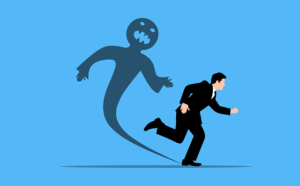When anxiety becomes excessive, irrational, or persistent, it may be indicative of an anxiety disorder.
The National Institute of Mental Health (NIMH) reports that anxiety disorders are the most prevalent mental health condition in the United States, affecting over 40 million individuals annually.
Anxiety disorders include panic disorder, social phobia (also referred to as social anxiety disorder), generalised anxiety disorder (GAD), and specific phobias.
Each type has its own symptoms and triggers, which will be discussed in detail in this article.
Moreover, it is essential for both treatment and prevention to comprehend the potential causes of these conditions.
Join us as we explore phobias and gain a greater understanding of what they are and how they affect our lives.
Fear Of Social Situations Constitutes Social Phobia
 Imagine yourself entering a room filled of people. Every action and thought of yours is being closely observed. You experience sweaty palms, a rapid heartbeat, and an inability to breathe.
Imagine yourself entering a room filled of people. Every action and thought of yours is being closely observed. You experience sweaty palms, a rapid heartbeat, and an inability to breathe.
This is what social phobia, also known as social anxiety disorder, feels like. Social phobia is characterised by an intense dread of being evaluated, rejected, or judged in social settings. It can manifest in a variety of ways, including public speaking and casual talk with strangers.
Common symptoms include excessive anxiety before social events, avoidance of social gatherings, or extreme distress while attending them. Thankfully, individuals with social phobia can use a variety of coping mechanisms to surmount their fears. These can range from basic breathing exercises to cognitive-behavioral therapy (CBT) techniques developed specifically for the treatment of social anxiety.
One can learn to manage their triggers while progressively becoming more comfortable in various social settings without feeling overwhelmed or panicked with patience and persistence.
Agoraphobia is a phobia of open or public spaces
Agoraphobia is a form of anxiety disorder marked by a dread of open or public spaces. People with agoraphobia frequently experience intense anxiety and dread in situations where escape may be difficult or assistance is difficult to obtain. This may involve crowded locations, public transportation, or even leaving their homes.
Individuals with agoraphobia may experience panic attacks, difficulty breathing, a rapid heartbeat, sweating, trembling, and feelings of being confined or out of control.
Frequently, these symptoms are treated with therapy and medication. Daily symptom management may also benefit from the use of coping strategies like deep breathing exercises and relaxation techniques.
Individuals are progressively exposed to feared situations until they become desensitised and more comfortable in those situations. It has also been demonstrated that support groups and virtual reality therapy are effective treatments for agoraphobia.
If you or someone you know is struggling with agoraphobia, it is crucial to seek professional help as soon as possible to begin addressing the underlying causes and discovering effective symptom management techniques.
Specific Phobias: An Extreme Aversion To Certain Objects Or Situations
Specific phobia is characterised by an irrational dread and avoidance of a specific object, animal, situation, or activity. These phobias can cause severe anxiety and panic attacks that hinder daily activities.
Common phobia triggers include heights, spiders, needles, flying, enclosed spaces such as lifts, and specific cuisines.
Individuals with specific phobia may experience physical symptoms when exposed to their feared stimulus. These symptoms include a rapid heartbeat, profuse sweating, trembling or uncontrollable shaking, shortness of breath or feeling choked, chest pain or discomfort, dizziness or lightheadedness leading to fainting episodes, and chest pain or discomfort.
Such overwhelming physical sensations may cause some individuals to completely avoid the dreaded object.
Numerous varieties of specific phobias have been shown to be effectively treated by overcoming techniques such as exposure therapy. Exposure therapy involves progressively exposing oneself to the feared object while learning coping skills to manage anxiety and panic during exposure sessions.
Prevalence rates differ based on the type of specific phobia, but are quite widespread among adults worldwide. Those afflicted with this condition can learn to live without being controlled by their anxieties if they receive the appropriate treatment and have the support of mental health professionals and loved ones.
Environmental And Biological Risk Factors
As much as we would like to believe that we have total control over our lives, there are sometimes factors at work that are beyond our comprehension. The biological and environmental risk factors that contribute to anxiety disorders are one such force. It is almost paradoxical that something beyond our control can have such a profound effect on us.
One of the most extensively investigated genetic factors for anxiety disorders is genetic predisposition. According to studies, individuals with a family history of anxiety disorders are more likely to develop these conditions themselves. Although genetics plays a significant role in the development of these conditions, it is not the only factor involved.
Childhood experiences also play a significant role in determining an adult’s susceptibility to anxiety disorders. Childhood trauma and other adverse experiences may increase the likelihood of developing an anxiety disorder.
Neurotransmitter imbalances, hormonal factors, and social influences also play a significant role in the development of these mental health disorders. Individuals who are aware of these various risk factors can take measures to effectively manage their symptoms without feeling guilty about their lack of control over their condition.
Trauma And Conditioned Responses
Now that we have discussed the biological and environmental factors that contribute to anxiety disorders, it is essential to understand the role that trauma and conditioning play in their development.
Childhood trauma, such as maltreatment or neglect, has been associated with an increased risk of later developing phobias. This may be due to the lasting effects of traumatic experiences on brain development and the way they influence our worldviews.
Pavlovian conditioning is one form of conditioning that can lead to phobias. This occurs when a neutral stimulus is associated with a negative experience, resulting in apprehension or anxiety towards the neutral stimulus.
However, just as conditioning can result in negative associations and fears, exposure therapy and desensitisation techniques utilise the principles of classical conditioning to reduce or eliminate these fears. By progressively exposing individuals to their feared object or situation in a safe and controlled environment, they can relearn positive rather than negative associations.
- Exposure therapy involves confronting one’s fears directly and progressively.
- Desensitisation techniques involve gradually increasing a person’s level of exposure until they no longer feel apprehensive.
- Virtual reality technology can be incorporated into exposure therapy for specific anxieties.
- Cognitive-behavioral therapy (CBT) is frequently combined with exposure therapy to address any underlying thought patterns or beliefs that could be contributing to the phobia.
Understanding how past experiences can influence our present anxieties is crucial for the treatment of anxiety disorders. Although childhood trauma and Pavlovian conditioning may increase a person’s likelihood of developing phobias, exposure therapy and desensitisation techniques offer hope for reducing these symptoms and enhancing overall quality of life.
Cognitive Behavioural Treatment
Cognitive Behavioural Therapy (CBT) is a psychotherapeutic approach that has been demonstrated to be effective in the treatment of anxiety disorders.
It concentrates on identifying and altering phobic-related negative thought patterns, beliefs, and behaviours.
Mindfulness practise, exposure therapy, relaxation techniques, and cognitive restructuring are CBT techniques and approaches.
The practise of mindfulness involves being present in the present moment and observing thoughts without judgement.
Exposure therapy involves progressively exposing patients to feared situations or objects until they no longer provoke a fear response.
Techniques of relaxation, such as deep breathing exercises, can help soothe the physiological responses of the body to anxiety.
Cognitive restructuring enables individuals to recognise and replace irrational beliefs with more rational ones.
By challenging negative self-talk and substituting it with positive affirmations, this technique hopes to alter the way people think about their fears.
CBT can aid individuals in overcoming their phobias and living happier lives by incorporating these various techniques.
Medication For Management Of Phobia
Consider a person who has suffered from social anxiety for years. Fear of being assessed and criticised by others continues to paralyse them in everyday situations despite their participation in various therapies. In such situations, medication can be a useful tool for managing anxieties.
1. Advantages and dangers:
The medications used to treat phobias can alleviate symptoms including panic attacks, obsessive thoughts, and avoidance behaviours. However, they carry potential risks such as dependency or addiction, withdrawal symptoms when discontinuing use, and negative drug interactions.
2. Alternative Medications:
Despite the fact that some individuals may benefit from medication, alternative therapies may be beneficial in conjunction with or in place of medication. These may include cognitive-behavioral therapy (CBT), mindfulness techniques, exposure therapy, and group therapy.
3. Dosage Guidelines & Side Effects:
When taking medication for the treatment of phobias, it is crucial to adhere to the dosing instructions provided by medical professionals and to closely monitor any potential adverse effects. Initially, common side effects may include drowsiness, nausea, migraines, or increased anxiety, but these symptoms typically subside over time.
Before beginning treatment for phobias, it is essential to have an open dialogue with your physician regarding any concerns regarding medication interactions. Those suffering from phobias can find relief through the use of safe and effective treatments, such as medications combined with alternative therapies, when accompanied by the proper guidance and support from healthcare professionals and lifestyle adjustments, such as exercise or dietary modifications, as needed.
How widespread are phobias among the general population?
The prevalence of phobia is a major concern among the general population. Recent studies indicate that approximately 12 percent of adults in the United States suffer from phobias throughout their lifetimes.
The risk factors for this condition include genetics, the environment, and even personal experiences, such as traumatic events. Phobias can have a significant impact on a person’s quality of life and relationships with others; if left untreated, they can contribute to social isolation, anxiety, and depression.
Those who seek assistance for their phobia have access to various treatment options, including cognitive-behavioral therapy (CBT), medication, and exposure therapy. Managing the symptoms of phobias may also be aided by coping mechanisms such as relaxation techniques and mindfulness exercises.
It is essential to address this issue due to its wide-ranging societal effects, which vary from economic costs associated with healthcare services to absenteeism among affected individuals.
Can phobias develop later in life, or are they present from birth?
Adults can develop phobias, which are frequently provoked by psychological or traumatic factors.
In addition to genetic predisposition, environmental factors such as stress and changes in lifestyle can contribute to the development of phobias later in life.
Changes in cognition and behaviour, such as negative thought patterns and avoidance, may exacerbate the condition.
Those afflicted with phobias of late onset can manage their symptoms and enhance their overall quality of life through early diagnosis and treatment with psychotherapy or medication.
Are there any natural remedies or alternative therapies for the treatment of phobias?
There may be natural remedies and alternative therapies that can help those with phobias manage their symptoms.
Mindfulness techniques, such as meditation and deep breathing exercises, have been shown to reduce anxiety levels in phobia sufferers.
The benefits of hypnotherapy in reducing anxiety responses have also been studied and found to be effective for some individuals.
Exercise therapy has been shown to enhance mental health in general and may also aid in the management of phobia symptoms.
Additionally, art therapy options may provide a non-threatening creative avenue for expressing fears and anxieties.
Although these techniques may not work for everyone, they are worth investigating as prospective phobia management tools.
For instance, Sarah had a severe phobia of flying but was reluctant to attempt medication. She decided to attempt hypnotherapy and discovered that it helped her feel more relaxed on flights.
How long does cognitive behavioural therapy typically take to be effective in treating phobias?
Cognitive behavioural therapy (CBT) is commonly recommended for the treatment of anxieties. Depending on the severity of the phobia and the individual’s response to therapy, the average duration of CBT for phobia treatment can vary.
However, research indicates that CBT has a high rate of success in reducing the fear and anxiety associated with various phobias. Exposure therapy, which involves progressively confronting feared situations or objects, is a common component of cognitive behavioural therapy for phobias.
Exposure therapy has also made use of virtual reality technology in recent years. Additionally, some people may benefit from group therapy sessions where they can receive support and learn coping strategies from others with similar phobia-related struggles.
Is it possible for someone to overcome their phobia completely, or will they always struggle with it to some degree?
It is a common query among those who suffer from phobias: Is it possible to overcome them permanently? Yes, but it will require time and effort.
Even after successful treatment, phobia relapses are possible, so progressive exposure to the feared situation or object may be necessary for long-term success.
Changes in lifestyle, such as exercise, healthy dietary habits, and stress management techniques, are also essential for anxiety management.
During times of intense tension, coping mechanisms such as deep breathing exercises and visualisation can help individuals manage their symptoms.
Additionally, support systems consisting of friends, family, and mental health professionals are essential for providing encouragement and direction throughout the recovery process.
In conclusion, anxieties are quite prevalent among the general population and can arise at any point in life.
Natural remedies and alternative therapies may provide temporary respite for anxiety disorders, but cognitive behavioural therapy is frequently the most effective treatment.
It is crucial to remember that overcoming a phobia requires time and effort. However, with the right treatment and support, it is possible to make substantial progress in managing and reducing the impact of these anxieties on daily life.
Therefore, if you’re struggling with a phobia, don’t hesitate to seek assistance from qualified professionals who can provide the direction and resources necessary to conquer this obstacle permanently!





